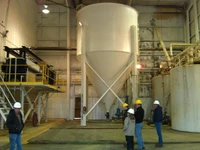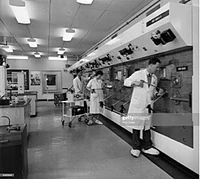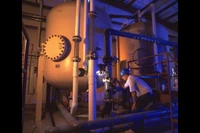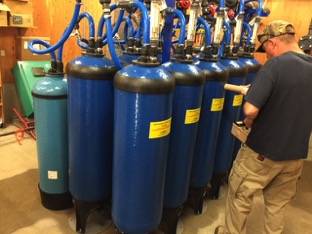Nuclear and Radiological Safety
Helping You Improve Nuclear and Radiological Safety
NUCLEAR AND RADIOLOGICAL SAFETY AND PROGRAM MANAGEMENT
Managed and provided oversight of a line organization of upward of 50 professionals working under task order contracts with US DOE prime contractors in support of the DOE EM Program (environmental restoration and waste management). These former nuclear weapons facilities and laboratories included the Nevada Test Site, Rocky Flats, Los Alamos, INEL, Sandia, Paducah, Fernald, KAPL, and Hanford. Work involved projects in radiation protection and operational health physics, nuclear and industrial safety, decontamination / decommissioning, integrated safety management, quality assurance and environmental monitoring and impact assessment.
Provided management and oversight of radiation protection and environmental compliance programs for the assessment, remediation, and decontamination of several large U. S. Army Corp of Engineers (USACE) FUSRAP uranium and thorium (TENORM) contaminated sites. These included Maywood (NJ) and the St. Louis Airport and Downtown sites (MO). Work performed under Federal (USDOE, USNRC, US Army) radiation safety and related environmental regulations including 10 CFR 20, 10 CFR 835 and Army Manual EM 385.
Was responsible for procuring and managing work assignments with U.S. DOE field offices and sites and commercial nuclear facilities. Built a nuclear services division “from scratch” which included line management and operational (e.g., profit/loss) responsibility for an organization grown to over 50 professional and support staff including establishment of several new company offices (Albuquerque, NM; Idaho Falls, ID; Richland, WA.).
Manager of Environment, Safety and Health and Radiation Safety Officer for Westinghouse Uranium Operations (Wholly Owned Subsidiary - Wyoming Mineral Corporation). Licensed and provided radiological operations oversight for 5 commercial-scale licensed uranium recovery facilities and several smaller R&D plants; designed the radiation protection and associated environmental monitoring programs and provided corporate E, S, H and license compliance oversight for in situ (leach) recovery facilities and uranium recovery as by-product from phosphoric acid production and from copper mining. Line manager for industrial hygiene and safety, licensing, radiation protection and environmental compliance functions and corporate radiation safety officer under numerous NRC/Agreement state operating licenses. Supervised HQ and uranium plant staffs including over 40 hygienists, health physicists, industrial safety and environmental professionals and technicians.
As member of the Radiological Assessment Team for the Independent Oversight and Assessments organization at Argonne National Laboratory, provided nuclear safety and radiological support for several annual inventories of all potentially dispersible, nonwaste radioactive material used and/or stored throughout the over 20 radiological and nuclear hazard class facilities at the laboratory. Major objective of these assessments is to ensure that building radiological inventories are maintained within each building’s specific radiological and special nuclear material assigned inventory limits established per requirements of DOE STD 1027 (Hazard Categorization and Accident Analysis Techniques for Compliance with DOE Order 5480.23, Nuclear Safety Analysis Reports) and ANL internal procedures for radiological and nuclear material accountability and control. As the Team’s health physicist / nuclear safety specialist, Mr. Brown conducted inventory assessments and numerous calculations to verify that DOE and ANL requirements and administrative limits were met related to acquisition of new radioactive material during the previous year, verification that the transfer of radioactive and nuclear inventory items was conducted in accordance with ANL procedures, that the determination of Pu-239 Fissile Gram Equivalents is being properly calculated per DOE standards and that specific nuclear facility safety control limits are being maintained.
As a consultant to British Nuclear Fuels, provided radiological engineering and health physics support for the decontamination / decommissioning of Magnox reactors at the Hinckley Point station in the UK. Prepared operational procedures and associated Radiation Work Permits (RWP) to assist plant HP organizations in assessing and controlling worker doses during D & D activities.
As a senior radiological and safety engineer at DOE's West Valley Demonstration Project, performed radiological engineering, hazard and nuclear safety analysis and risk assessments for decontamination and conversion of a former nuclear fuel reprocessing plant for the processing and vitrification of high-level nuclear waste. Radiological engineer for preparation of environmental assessments (EA) and preliminary and final safety analysis reports (PSAR/FSAR) for the supernatant treatment and for the vitrification systems. These processes involved the pretreatment and solidification into borosilicate glass of 30 million curies of mixed fission products (cesium, strontium) and actinides (uranium, plutonium) and cementation of resultant low level wastes.
Performed radiological and probabilistic risk assessments (PRA) for the 8 nuclear weapons plants at Rocky Flats that processed depleted and highly enriched uranium and plutonium. Primary techniques included Failure Mode and Effects Analysis (FMEA) and Fault and Event Tree Analysis (FETA). Work also included the development of Operational and Technical Safety Requirements (OSR, TSR) and Limiting Conditions of Operations (LCO) for plutonium and uranium processing, product manufacturing and transuranic waste disposal systems. Performed PRA-based accident analyses and co-authored Safety Analysis Reports (SARs) for the 8 nuclear weapons facilities.
As member of the original WIPP Joint Integration Office (JIO), was the JIO health physicist and radiological engineer. As such, was contributor to a number of early WIPP radiological and nuclear safety related assessments and documents including the WIPP Safety Analysis Report and Waste Acceptance Criteria (WIPP-WAC) for both Contact and Remote Handled TRU wastes. Was a member of a number of compliance inspection teams that performed assessments of the major TRU waste-generating sites throughout the DOE complex to evaluate site compliance with the WIPP-WAC prior to being authorized to send TRU waste to WIPP.




